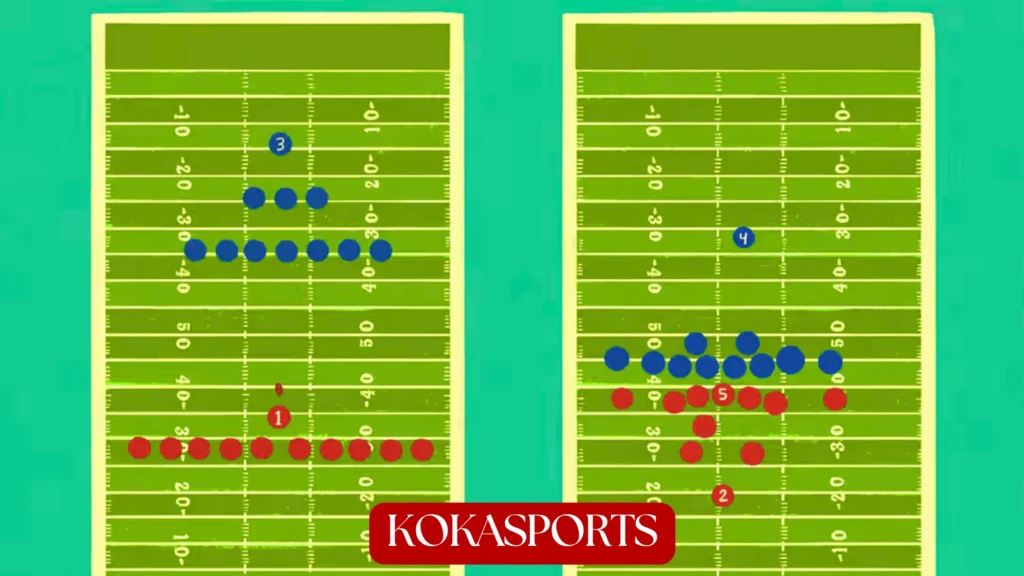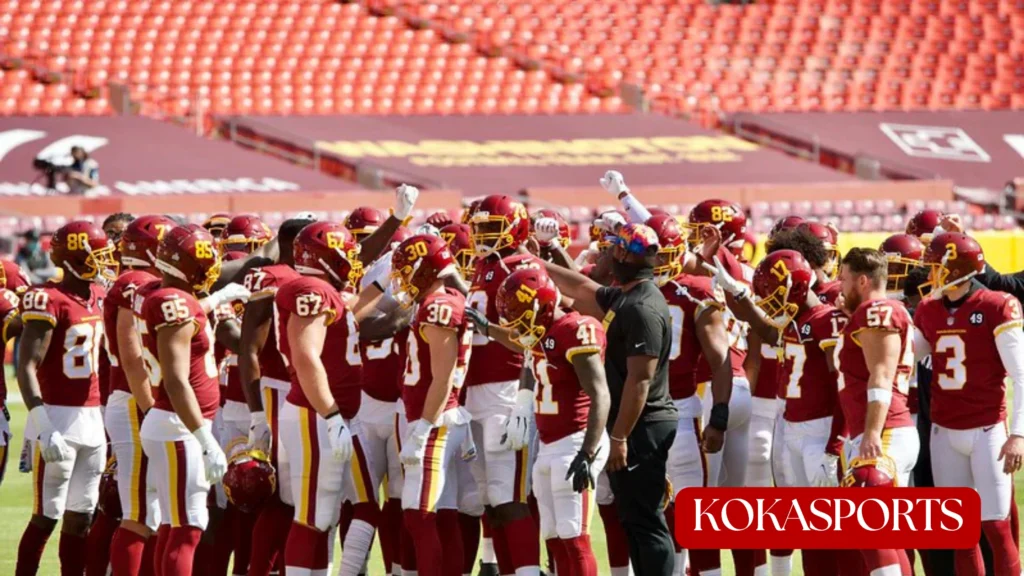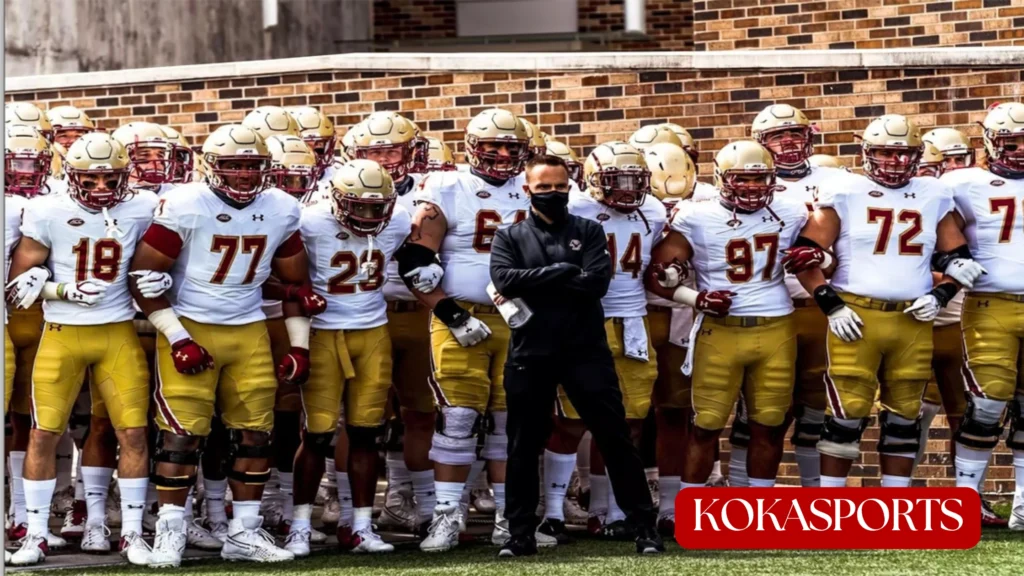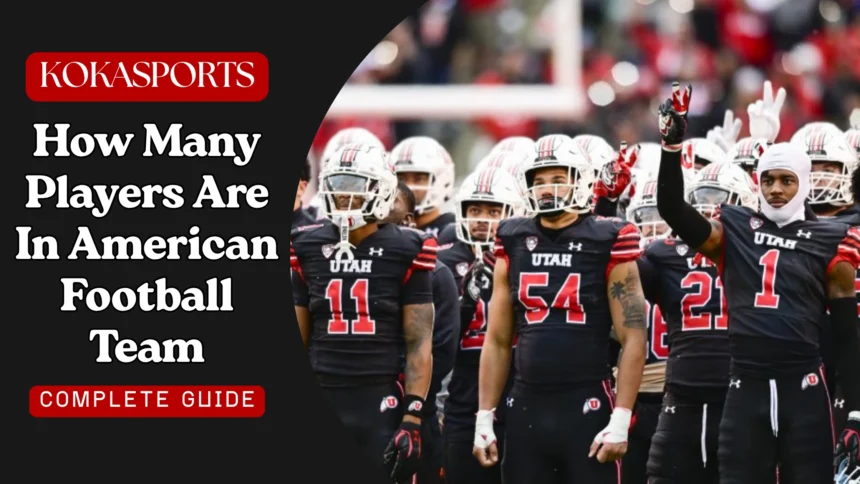When you watch an American football game on television, you might wonder exactly how many people make up a team. How many players are in American football team? The answer is more complex than you might think. While you see 11 players on the field at any given moment, the complete structure of a football team involves many more athletes working together behind the scenes.
Team size and roster structure matters because it helps fans appreciate the depth of strategy and planning that goes into every game. The National Football League (NFL), college football, and high school football all have different rules about how many people can be on a team. This guide will walk you through everything you need to know about team sizes, from the 11 players on the field during play to the full 53 players on the active roster in professional football, plus additional practice squad members who train with the team.
How Many Players Are in American Football Team?

The Basics: 11 Players on the Field at a Time
At any moment during an American football game, there are exactly 11 players on each side of the field. This means a total of 22 players are actively playing at once – eleven on offense trying to move the ball forward, and 11 defensive players working to stop them. This rule applies whether you’re watching the NFL, college football, or high school football.
The team with the ball uses their offensive team to advance down the football field. These 11 offensive players include the quarterback who throws or hands off the ball, offensive lineman who protect the quarterback, a running back who carries the ball, and receivers who catch passes. Meanwhile, the defensive team sends out their own eleven players to tackle ball carriers and prevent scoring.
What makes football interesting is that these eleven players change throughout the game. Teams use substitutions constantly, rotating fresh football players in and out based on the situation. For example, when a team needs to kick a field goal, they send in their special teams unit with a kicker, holder, and long snapper. When the opposing team has the ball, defensive specialists come onto the field. This rotation system means that while only 11 players per side are on the field at a time, dozens more are ready to play throughout the game.
Total Players on a Full Roster
A roster is the complete list of players officially part of a team. In the NFL, teams can have 53 players on their active roster during the regular season. This gives coaches plenty of options for substitutions and allows them to have backups for every position. Additionally, NFL teams maintain a practice squad of up to 16 players who train with the team but don’t suit up for games unless promoted.
College football teams operate differently. They typically have 85 scholarship players, but when you count walk-ons (non-scholarship athletes), many programs have over 100 players on their full roster. This larger size helps colleges develop young talent and prepare for the future.
High school football teams vary the most in size. Small schools might have only 25 to 30 players total, while large schools could have 70 to 80 athletes. At this level, many players play both offense and defense because there simply aren’t enough people to specialize in just one role.
Read More: How Many Players Are in a Football Team? Complete Guide
| Level | Active Game Day Players | Total Roster Size |
|---|---|---|
| NFL | 48 players | 53 + 16 practice squad |
| College | Varies (60-70 travel) | 85-100+ players |
| High School | 25-80 players | 25-80 players |
How Many Players Are on an NFL Team?
The NFL Roster Breakdown
The NFL roster structure is carefully regulated. During the football season, each NFL team maintains exactly 53 active players. These are the athletes who can be activated for any NFL game. However, not all 53 players on the active roster dress for every game. On game day, teams can only activate 48 players, meaning five players from the roster must be declared inactive.
Beyond the active roster, teams have their practice squad. These practice squad players are essentially the team’s reserves. They practice with the team all week, helping starters prepare by simulating the opposing team during drills. The practice squad can hold up to 16 athletes, and these players can be promoted to the active roster at any time if injuries occur or if a quarterback, receiver, or other position needs reinforcement.
The NFL also uses an injured reserve list. When players get hurt and can’t play for several weeks, teams place them on this list, which frees up a roster spot for a healthy replacement. This system ensures that teams always have enough healthy bodies ready to compete.
How the NFL Season Affects Roster Size
Roster sizes change throughout the year. During the preseason, NFL teams can carry up to 90 players as they evaluate rookies and free agents. This gives coaches time to see who deserves a spot on the final 53-man roster. After the preseason ends, teams must cut down to exactly 53 players before the first regular season game.
The NFL draft plays a crucial role in building rosters. Each year, 32 teams select new players over seven rounds, adding roughly 260 rookies to the league. These drafted athletes compete for roster spots during training camp and preseason games. Not all drafted players make the final cut – some end up on practice squads, while others leave the league entirely.
Throughout the season, rosters remain at 53, but the specific players change due to injuries, trades, and performance issues. Teams constantly sign and release players, especially from their practice squad, to address immediate needs.
What Positions Make Up an NFL Team?
An NFL roster includes specialists for every situation. On offense, the quarterback is the most important player, calling plays and distributing the ball. The offensive lineman (usually five players) form a protective wall in front of the quarterback. Running back positions typically have three to four players on a roster, while wide receiver spots might have five to seven athletes competing for playing time. Teams also carry two to three tight ends who both block and catch passes.
Defense requires equal specialization. The defensive line has four players who rush the passer. Linebackers, usually three to five per team, play in the middle of the field and defend against both runs and passes. Cornerbacks and safeties, together called defensive backs, protect against passing plays. A typical NFL roster might have seven players in the defensive backfield.
Special teams include the kicker who attempts field goals and extra points, the punter who kicks on fourth down, and the long snapper who delivers the ball on kicks. Return specialists handle kickoffs and punts. While these specialists have specific roles, many regular offensive and defensive player positions also contribute to special teams coverage and blocking.
How Many Players Are on a College Football Team?

College Football Roster Size
College football operates with much larger rosters than the NFL. The NCAA allows Division I programs to give 85 full scholarships. However, the actual number of players on college football teams often exceeds 100 when you include walk-ons. Walk-ons are athletes who join the team without scholarship money, paying their own way through school while competing for playing time.
Why are college rosters so large? First, college coaches need to develop young talent over several years. Freshmen rarely play significant minutes, so teams need depth. Second, the college game involves more players because of redshirting – holding players out for a year to preserve eligibility. Third, injuries happen frequently, and colleges don’t have practice squads like the NFL, so they need extra bodies on the roster.
For away games, colleges typically travel with 60 to 70 players rather than their entire roster. This helps control costs and ensures only the players likely to see action make the trip.
Differences Between College and NFL Rosters
The biggest difference between college and NFL is roster flexibility. College teams can carry as many players as they want beyond the 85 scholarship limit. Some programs have 120 or more total athletes. The NFL strictly limits teams to 53 plus 16 practice squad members.
Another key difference is player development. In college football, younger players spend years learning the system before playing. The NFL expects rookies to contribute immediately. College rosters also include walk-ons who might never play in a game but provide valuable practice competition. The NFL has no equivalent – every player must be skilled enough to potentially play on Sunday.
Offensive positions and defensive positions are filled differently too. College teams might carry six or seven quarterbacks at various development stages, while NFL teams typically keep only two players at the position, occasionally adding a third.
How Many Players Are on a High School Football Team?
Typical High School Football Roster Size
High school football varies dramatically based on school size and location. Small rural schools might field teams with just 25 to 30 players total. These programs struggle to fill all positions on the field and often require athletes to play both offense and defense plus special teams. A single player might be a wide receiver on offense, a cornerback on defense, and a kick returner on special teams.
Large suburban and urban schools can have 70 to 80 players on a team. These programs function more like college teams, with separate offensive and defensive units and plenty of backups. Players specialize in specific roles rather than playing multiple positions.
The smaller roster size at many high schools creates unique challenges. Injuries hurt more when you don’t have depth. Coaches must be creative with substitutions and formations. Some schools run simpler offensive and defensive schemes because they can’t dedicate enough practice time to complex systems with limited personnel.
The Roles – American Football Positions Explained
Offensive Positions
The offense has several position groups working together. The quarterback is the field general, making decisions and distributing the ball. A quality quarterback can make an average team competitive. Elite quarterbacks like Patrick Mahomes and Josh Allen can carry their teams to championships.
The offensive line consists of five players: center, two players at guard, and two tackles. These offensive lineman rarely get headlines but are essential for success. They create running lanes and protect the quarterback from the opposing players trying to sack him. Without a strong offensive line, even the best quarterbacks struggle to succeed.
Skill positions include running back, wide receiver, and tight end. Running backs carry the ball and catch passes out of the backfield. Most teams carry three to four players at this position to handle the physical demands. Wide receivers stretch defenses vertically and horizontally. Teams typically have five to six receivers on their roster, each bringing different skills – some are deep threats, others excel at short routes or blocking.
Defensive Positions
Defense mirrors offense in complexity. The defensive line, typically four players, rushes the passer and stops running plays. These athletes must be strong, quick, and tireless since they battle offensive linemen every play. Teams rotate defensive linemen frequently to keep them fresh, which is why depth at this position matters tremendously.
Linebackers operate in the middle of the field, defending against runs and short passes. They’re the quarterbacks of the defense, calling adjustments and making tackles. Teams usually have three to five players who can play linebacker, with different specialists for passing downs versus running situations.
The secondary includes cornerbacks and safeties. Cornerbacks cover wide receiver positions, playing man-to-man or in zone coverage. This is one of the hardest jobs in football because receivers know where they’re going while cornerbacks must react. Safeties provide deep coverage help and support against the run. A typical defense has four to seven players in the secondary competing for playing time.
Special Teams
Special teams handle kicking situations. During a field goal attempt, eleven players from each team take the field at one time. The offense sends out their kicking unit with a holder, kicker, and long snapper, plus eight blockers. The defense tries to block the kick or create pressure.
Kickoff and punt teams involve 22 players on the field – eleven per team. These units include some starters but mostly backups and active players who specialize in coverage. Return specialists, often fast wide receiver or running back positions, handle returns and can change games with one explosive play.
Field goal situations are critical in close games. The kicker must be accurate from various distances, the long snapper must deliver the ball precisely in 0.7 seconds, and the holder must place it perfectly with the laces facing forward. Meanwhile, ten other players must block the defensive team from breaking through. A single breakdown can result in a blocked kick or missed opportunity.
The Practice Squad and Player Development

What Is a Practice Squad in the NFL?
The practice squad in the NFL serves as a developmental league within each team. Teams can carry up to 16 practice squad members who aren’t on the active roster but practice daily with the team. These athletes earn significantly less money than active roster players – typically around $12,000 per week compared to the league minimum of $50,000+ weekly for active players – but remain in the NFL system, ready for promotion.
Practice squad players help starters prepare for upcoming opponents. They run the opposing team plays during practice, giving the defense a realistic look at what they’ll face on Sunday. Similarly, they simulate opposing defenses for the offense to practice against. This role is crucial because it allows starters to practice against different styles without risking injury in full-contact situations.
Eligibility for the practice squad has specific rules. Players typically need fewer than three years of NFL experience, though teams can have up to six players with unlimited experience. Any team can sign another team’s practice squad player to their active roster, creating competition for talented developmental athletes. This rule encourages teams to promote promising practice squad members before losing them to competitors.
Practice Squads in College and High School
College football doesn’t have formal practice squads, but the scout team serves a similar purpose. These are mostly younger players or backups who simulate opponents during practice. Being on the scout team is how freshmen learn the system and earn future playing time. Scout team players might run Oklahoma’s offense all week to prepare for an upcoming game, giving them valuable repetitions even if they don’t play on Saturday.
High school football teams operate similarly with their depth charts. Younger players and backups provide practice competition for starters, learning the system while helping veterans prepare. However, with smaller rosters, high schools can’t afford to have players who only practice – everyone must be ready to play in games if needed due to injuries or special situations.
How Player Numbers Affect Team Strategy and Gameplay
Substitutions and Rotations
Modern football involves constant player rotation to maintain peak performance. Defensive linemen might play only 50-60% of defensive snaps, rotating to stay fresh against tired offensive linemen. This rotation advantage becomes crucial in the fourth quarter when fresh legs can dominate exhausted opponents. Offensive players also rotate, especially at running back where the physical pounding requires multiple ball carriers to share the load.
Coaches create specific packages with different positions grouped together for particular situations. A goal-line package might include extra offensive lineman to push forward for short yardage. A prevent defense uses extra defensive backs to stop deep passes. These substitutions mean dozens of players on offense and players on defense contribute even though only eleven players are on the field at the same time.
The side of the field and game situation dictate which players enter. Third-and-long brings pass-rushing specialists and extra defensive backs. Short-yardage situations require powerful blockers and runners. This strategic complexity is why NFL teams need 53 players despite only fielding 11 at once. The chess match between coaches involves not just play-calling but also which specific athletes matchup best against the opposing team personnel.
Impact on Game Planning
The number of players available affects every decision coaches make. If a team has four players capable of playing quarterback, they might use one as a gadget player on trick plays. If injuries deplete the receiver position, teams adjust their offense to run more and use shorter passing routes that require fewer receivers.
Coaches and players spend countless hours studying how to maximize each athlete’s abilities. The team on the field for any play represents the coach’s best judgment about which combination gives them the highest chance of success. This is why depth matters tremendously – injuries to key positions can derail an entire season. Teams with strong backups can overcome adversity, while shallow rosters crumble when starters get hurt.
Conclusion
How many players are in American football team? The answer varies by level. During play, exactly 11 players per side take the field, totaling 22. An NFL team maintains 53 active players plus 16 practice squad members. College football rosters often exceed 100 players, while high school football teams range from 25 to 80 athletes depending on school size.
From the quarterback leading the offense to the wide receiver catching passes and the offensive lineman protecting in the trenches, each position plays a vital role. Whether you’re watching an NFL game on Sunday or your local high school team on Friday night, you now appreciate the complete structure behind every football team – not just the 11 athletes visible on each play, but the dozens more who make every game possible.
FAQs
Are there 11 or 12 players on a football team?
There are exactly 11 players per team on the field during play; having 12 results in a penalty.
How many players are allowed in American football?
11 players per team are allowed on the field at once, while NFL teams can have 53 on their active roster plus 16 practice squad players.
Can a football team have 8 players?
No, teams must have exactly 11 players on the field to legally run a play; fewer than 11 prevents the play from starting.
Do all NFL teams have 53 players?
Yes, all NFL teams must maintain exactly 53 players on their active roster during the regular season.




